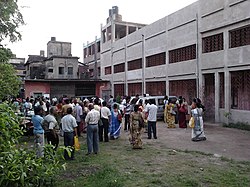West Bengal Joint Entrance Examination
This article needs additional citations for verification. (December 2012) |
West Bengal Joint Entrance Examination or the WBJEE is a state-government controlled centralized test, conducted by the West Bengal Joint Entrance Examinations Board for admission to many private and governmental medical and engineering institutions in West Bengal. The test is taken after the 12th grade for admission to graduation (also known as Bachelors) courses. The exam can be taken by those who studied Pure Science stream in plus two level with the specific subjects tested in the examination, which are Physics, Chemistry, Mathematics and Biology. There are actually two separate tests for medical (also called WBJEE Medical) and engineering (also called WBJEE), the difference being that the medical test has the Biology paper while the engineering test has the Mathematics paper.
Every year approximately 300,000 people take the examination and it is increasing. Students of both West Bengal Council of Higher Secondary Education and the Central Board of Secondary Education, Council for the Indian School Certificate Examinations board take the test, though it is dominated by the former. It's a prestigious test, and there are few students of science stream in West Bengal who don't take at least one of the two tests.
From 2017, WBJEE (Medical) was postponded and NEET (UG) is considered as medical entrance exam for undergraduate course throughout the India (including West Bengal).

History
In 2016, WBJEE exam will be conducted on 17 May,2016 for admissions to various undergraduate engineering courses in West Bengal. From 2012, the old pattern was Phased out and the WBJEE would consist of only MCQ questions which differs from the previous years by the fact that 2 Marks Short answers type questions are replaced by MCQ with the same weightage of marks. In 2016 there will be a different type of pattern in Biology question paper. Category-I consists of (Q.1 to Q.90) carrying one mark each, for which only one option is correct. Category-II consists of (Q.91 to Q.105) carrying two marks each, for which only one option is correct. Category-III consists of (Q.106 to Q.120) carrying two marks each, for which one or more than one option may be correct. Starting from 2012, all papers consist of 80 MCQ type question divided in two section. Section one consists of 60 MCQs of 1 marks each and Section two consists of the remaining 20 MCQs of 2 marks each.
Negative marking is applicable. 30% of the total marks of a question will be deducted for every incorrect answer.[1]
In 2006, the WBJEE contained only objective-type MCQ (Multiple Choice Question) type questions. This announcement attracted mixed reactions with some applauding it as a step towards the future while others have said that opting for MCQ when other tests were slowly phasing out MCQ because of studies showing MCQ failed to properly judge aptitude is a folly.
The WBJEE 2008[2] was Postponed Due To Paper Leak, after the Physics, Chemistry and Biology papers were leaked. Two persons, Arun Chowdhury and Mihir Dandapatt, were arrested on Saturday in West Midnapore's Ghatal, where the three papers were being sold for Rs 2.5 lacs.
WBJEE 2011 exam was postponed from 17 April 2011 to 22 May due to election date issues in West Bengal.
Participating Institutes
Various colleges intake students based on WBJEE Ranks. The Central Selection Council conducts a counselling session for students where colleges are allotted to them. The institutions that take part in this session are:
- Kalyani Government Engineering College
- Jadavpur University
- Kalyani University Science Instrumentation Centre
- University Institute of Technology, Burdwan
- Uttar Banga Krishi Viswavidyalaya
- West Bengal University of Animal and Fishery Sciences
- West Bengal University of Health Sciences
- West Bengal University of Technology and its affiliated institutes.
- University of Calcutta
Recently the Bengal Engineering and Science University, Shibpur (BESU) which participated in WB-JEE till 2014 has been upgraded to IIEST Shibpur. IIEST (formerly BESU) now uses the national level Joint Entrance Examination for admission of its undergraduate students, as in the case with other national level engineering institutes like National Institutes of Technology and Indian Institutes of Science Education and Research. The University of Calcutta opened up its admission to the new four year B.Tech course through WBJEE from 2015.
References
- ^ https://web.archive.org/web/20120504003657/http://wbjeeb.in/pdf_2012/JEM_and_FAQ.pdf. Archived from the original (PDF) on May 4, 2012. Retrieved April 21, 2012.
{{cite web}}: Missing or empty|title=(help); Unknown parameter|deadurl=ignored (|url-status=suggested) (help) - ^ WBJEE 2008 paper leak report
